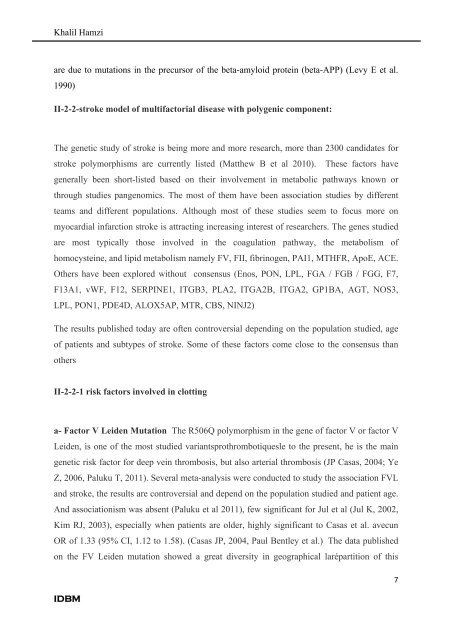GENETICS OF STROKE IN 21 st CENTRY - SciReNe
GENETICS OF STROKE IN 21 st CENTRY - SciReNe
GENETICS OF STROKE IN 21 st CENTRY - SciReNe
Create successful ePaper yourself
Turn your PDF publications into a flip-book with our unique Google optimized e-Paper software.
Khalil Hamzi<br />
are due to mutations in the precursor of the beta-amyloid protein (beta-APP) (Levy E et al.<br />
1990)<br />
II-2-2-<strong>st</strong>roke model of multifactorial disease with polygenic component:<br />
The genetic <strong>st</strong>udy of <strong>st</strong>roke is being more and more research, more than 2300 candidates for<br />
<strong>st</strong>roke polymorphisms are currently li<strong>st</strong>ed (Matthew B et al 2010). These factors have<br />
generally been short-li<strong>st</strong>ed based on their involvement in metabolic pathways known or<br />
through <strong>st</strong>udies pangenomics. The mo<strong>st</strong> of them have been association <strong>st</strong>udies by different<br />
teams and different populations. Although mo<strong>st</strong> of these <strong>st</strong>udies seem to focus more on<br />
myocardial infarction <strong>st</strong>roke is attracting increasing intere<strong>st</strong> of researchers. The genes <strong>st</strong>udied<br />
are mo<strong>st</strong> typically those involved in the coagulation pathway, the metabolism of<br />
homocy<strong>st</strong>eine, and lipid metabolism namely FV, FII, fibrinogen, PAI1, MTHFR, ApoE, ACE.<br />
Others have been explored without consensus (Enos, PON, LPL, FGA / FGB / FGG, F7,<br />
F13A1, vWF, F12, SERP<<strong>st</strong>rong>IN</<strong>st</strong>rong>E1, ITGB3, PLA2, ITGA2B, ITGA2, GP1BA, AGT, NOS3,<br />
LPL, PON1, PDE4D, ALOX5AP, MTR, CBS, N<<strong>st</strong>rong>IN</<strong>st</strong>rong>J2)<br />
The results published today are often controversial depending on the population <strong>st</strong>udied, age<br />
of patients and subtypes of <strong>st</strong>roke. Some of these factors come close to the consensus than<br />
others<br />
II-2-2-1 risk factors involved in clotting<br />
a- Factor V Leiden Mutation The R506Q polymorphism in the gene of factor V or factor V<br />
Leiden, is one of the mo<strong>st</strong> <strong>st</strong>udied variantsprothrombotiquesle to the present, he is the main<br />
genetic risk factor for deep vein thrombosis, but also arterial thrombosis (JP Casas, 2004; Ye<br />
Z, 2006, Paluku T, 2011). Several meta-analysis were conducted to <strong>st</strong>udy the association FVL<br />
and <strong>st</strong>roke, the results are controversial and depend on the population <strong>st</strong>udied and patient age.<br />
And associationism was absent (Paluku et al 2011), few significant for Jul et al (Jul K, 2002,<br />
Kim RJ, 2003), especially when patients are older, highly significant to Casas et al. avecun<br />
OR of 1.33 (95% CI, 1.12 to 1.58). (Casas JP, 2004, Paul Bentley et al.) The data published<br />
on the FV Leiden mutation showed a great diversity in geographical larépartition of this<br />
IDBM<br />
7


